Had I known I’d be sleeping at icy campsites, and pushing my body’s ability to cope with altitudes over 15,400 feet, I might have had second thoughts about the three-day trek from Urubamba (in the Sacred Valley of Peru) to Lares hot springs, 20km away on the other side of a mountain range that we had to climb over.
But I’m glad I didn’t think about it too much beforehand, as not going would have been an even bigger mistake.
My fearless leader was Miguel, who had already introduced me to some magical spots in Peru, including Huchuy Cosqo, Machu Picchu, Kinsa Cocha, and more. The ultimate motivation for this chosen trek: to soak our sore muscles at the end of it all in Lares hot springs.
This post was originally published in 2014. It has since been updated for accuracy of links and content.
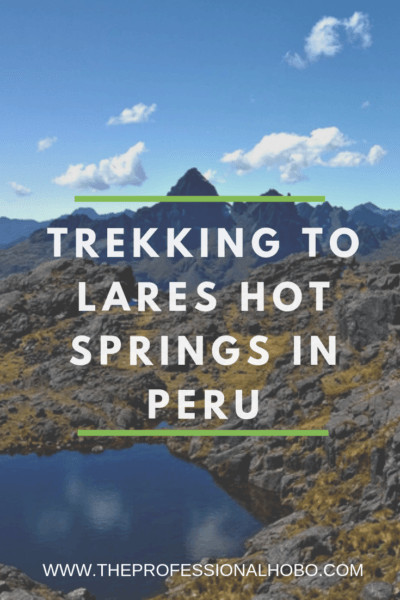
Day One – Following the River
Hiking up from Urubamba, we followed a river up, up, and up some more, threading a valley to the river’s very source – a series of little lakes and lagoons way up in the Andes.
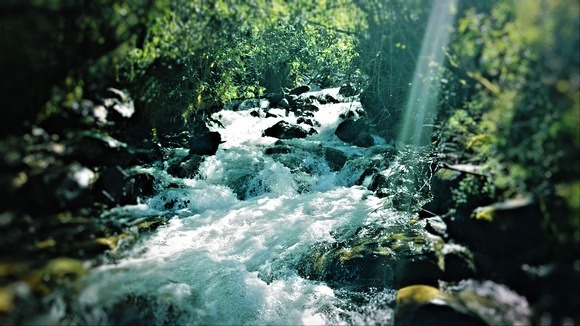

An Old Way of Life
Passing through the remote community of Badacancha, I was amazed at how many people in Peru live as they did hundreds – even thousands – of years ago. This small community has no road to it, and is a two hour walk to the nearest road. The 10 families who live here largely sustain themselves on the land, tending their gardens and animals and living in stone houses that look hundreds of years old.
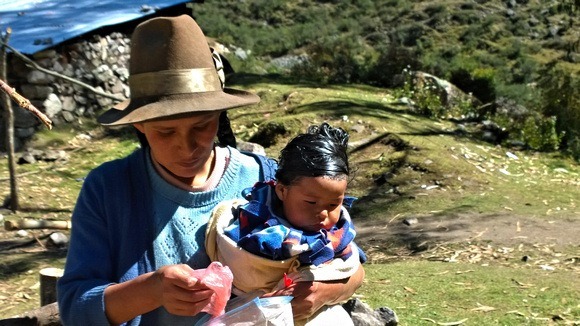
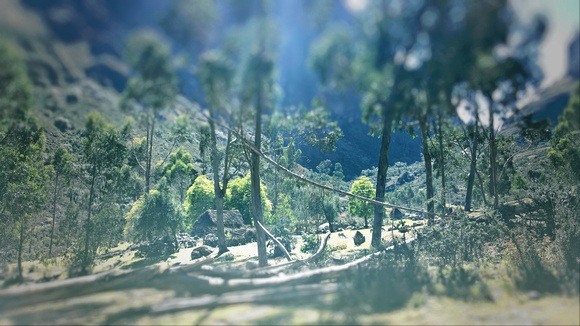
The Donkey Trail
Although we were relatively alone on the trail, we did have company; we passed wranglers with their horses/donkeys/mules/llamas regularly (or rather, they passed us), carrying goods and tending to the needs of various groups camping and trekking back and forth along the trail. Despite occasionally passing these groups, we were quite isolated in our Andean paradise.
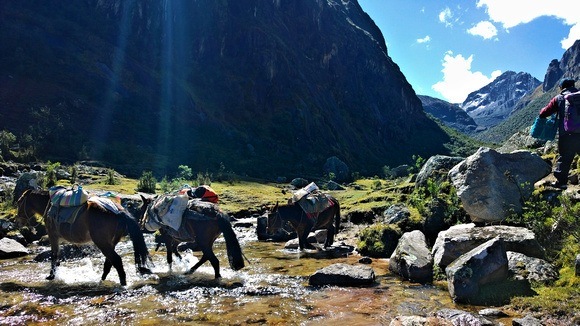

Camping and Chilling (Literally)

We camped at 4,300 metres (over 14,000 feet) and immediately felt the chill when the sun disappeared behind the mountains that surrounded us. The following morning the tents were covered in ice and I felt the effects of the thin cold air.
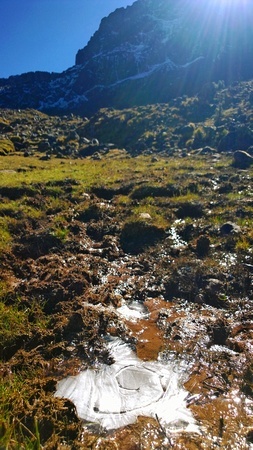
Day 2: Over the Pass, and Pushing Through

Stamping my feet to (unsuccessfully) ward off the cold, we began the next day’s trek heading ever-higher towards the snowy Sillacasa pass at 4,700 metres (over 15,400 feet). Although I’ve never felt the effects of the Andes’ high altitudes (even at Kinsa Cocha which was almost as high), my heart pounded with each step and frequent rests were required.

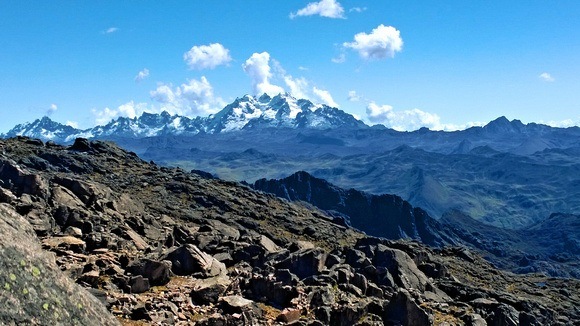

From this point onwards the tough work was done; it was just a knee-wrenching descent of 1,500 metres (5,000 feet) into the next valley and onwards to Lares, where the hot springs awaited.
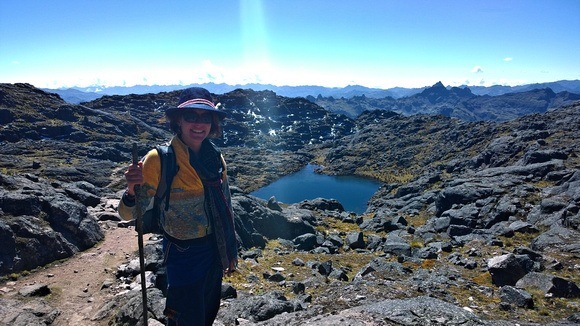
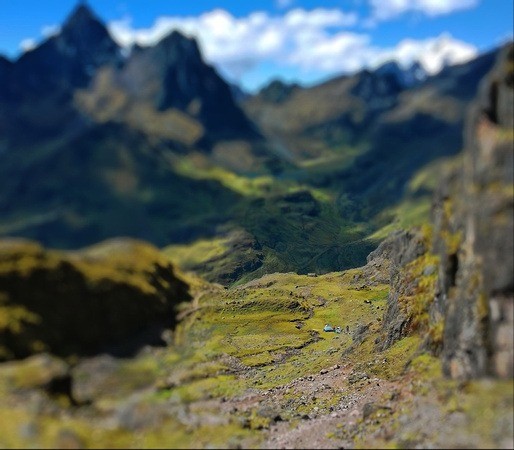

Three Days….Into Two
“Okay, we have two choices,” started Miguel after lunch. “We can camp tonight at a beautiful spot about an hour before Lares hot springs, or we can push through and camp at the hot springs tonight.” The sparkle in his eye at the mention of “hot springs” and “tonight” in the same sentence revealed his preference, and to me it didn’t make sense to camp only an hour away. I wanted to celebrate the hard work of this trek with a hot soak….as soon as possible.
And so we pushed through, totalling nine hours of walking for the second day, including a 400 metre ascent followed by a 1,500 metre descent.


Lares Hot Springs
The decision to push through and finish the trek in two days was a sound one, I thought that evening, while soaking in the hottest of the four naturally hot pools that range in temperature from warm to scalding. I barely remember passing out in my tent and I slept for an unbelievable 11 hours before waking up and heading right back to the hot springs for another soak.
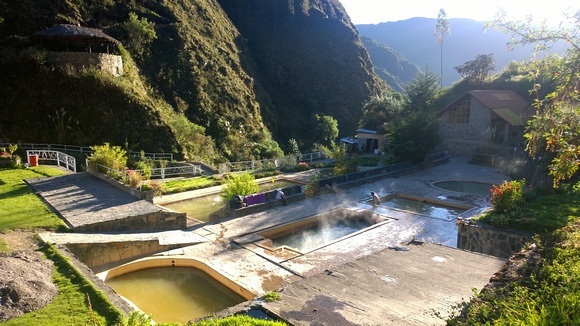
If the dirt colour of the water turns you off, join the club. But having been to natural hot springs in Panama and Sulphur Springs in Grenada, I wasn’t surprised by the opaque brown water, and it smelled much less of sulphur than other hot springs I’ve visited in places like New Zealand and Canada.
Getting to Lares Hot Springs
You don’t have to trek for 2-3 days to reach the isolated valley of Lares (although if you’ve got it in you, I’d recommend it); there are buses from the town of Calca, but I have been warned that it’s a nauseating two-hour journey full of twists and turns. Indeed in returning from Lares hot springs after our trek, we took a car, and although the scenery was a stunning cross between Scottish Highlands and the set of Lord of the Rings, I can see how being in a cramped bus hurtling up and down the bumpy narrow dirt switchbacks might leave a little something to be desired.
Although it wasn’t easy, I loved earning that long soak in Lares hot springs with a three day trek.
Below are a few different ways to experience a Lares Trek or day trip to Lares. I highly recommend hiking in with a guide, as it’s an arduous journey that requires the assistance of porters with mules.
What’s the most rewarding trek you’ve ever done?
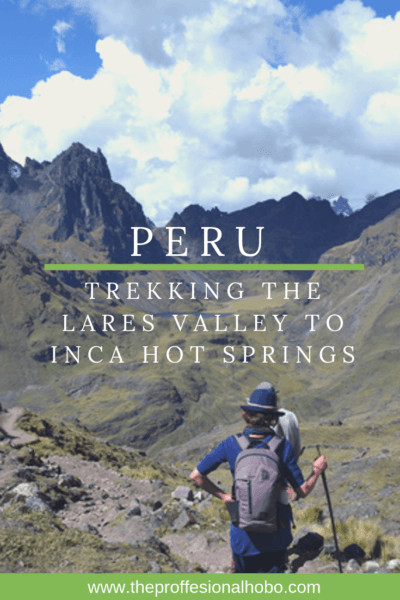

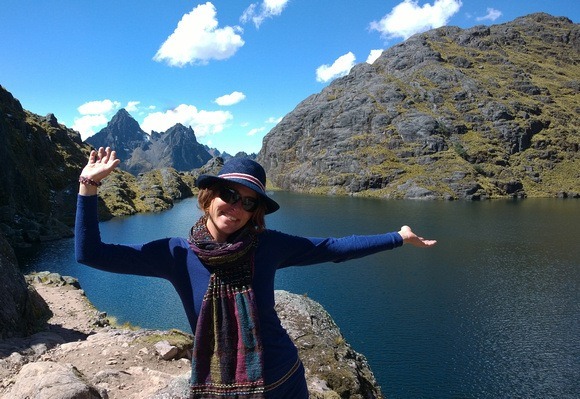

Nora,
I usually read from an RSS feed so I don’t get over to your blog to comment often, but I wanted to tell you that I have really enjoyed your posts from Peru. The pictures and stories are great, and I particularly enjoy your stories of personal triumph, pushing yourself to succeed even with the challenge of your injuries. Thanks for sharing these, they are truly inspiring.
Thank you so much, Eric! My three months in Peru are drawing to a close, and reflecting on what I’ve done in this time, I’m pretty pleased. It has been a great adventure!
incredible! lucky girl I would love to of seen all that, specially the people of villages living the way they did years ago. However the icy cold tents does not spark my “let me! let me!” button. How did you sleep?! Did you even manage to sleep? Bet it was all worth it, the trekking pictures look great
Hey Rebecca,
I don’t like the cold, and I’ve been on a permanent mission to avoid winter since I started traveling in 2007….so far quite successful. My time in Peru has tested my dislike for the cold in a general sense (even in the Sacred Valley the altitude is so high that it gets quite cold at night), but like you say – it has totally been worth it.
As for how I slept: the first night, not so well. But the second night after the hot springs – like a baby! 🙂
Your new camera is dramatically better than the old one.
@Mike – TELL me about it! 🙂
Great adventure Nora! Sooo jealous.
Have shared it on our FB page.
Keep up the adventuring 🙂
Frank
Thanks, Frank! Peru is awesome. The adventures continue…
What an awesome place to camp out. If it was me I would trek all the way to the hot springs and enjoy the view rather than sitting on a bus. I really like your adventures here.
Thanks, Jeanette! I was just speaking with somebody yesterday who took the bus to Lares….and puked enroute….I think the trek is best! 🙂
Thanks for sharing a beautiful and adventurous trip to Peru. It was really thrilling and the part of getting ice layer on the surface in the morning was best. The blog is really amazing. Even, We provide information on travel places from Pune, be it beaches, hill stations. Check the link mentioned in the signature for more information.
Thanks,
Shivani
http://punefirst.com/travel/
Hi Shivani,
Thank you – and yes, although I don’t particularly enjoy the cold, that ice picture was fun to take!
Thank you for posting this link. Seven years ago my husband and I rented a motorcycle and road to Lares without knowing what was in store for us. Our 8 day hike was washed out so we decided to rent a motorcycle and took the recommendation to take the route to Lares.
I have seen one or two articles dis the hotsprings, but they are fantastic and the locals are very friendly as long as you are polite.
We still love talking about staying in the dirt floor hut under warm hand woven blankets for one night of our honey moon in Pery/Equadore.
Lares is worth the visit for all those who love adventure and do not need the prince/princess treatment.
Hi Christine,
I’m glad you made it to Lares, and on a motorcycle no less! Very cool. Glad you found it as special as I did!
Nora, so glad I found your blog! We are going to be in Peru 9-5 to 9-21 and are planning to do this hike, so excited! Your description and pictures are excellent, great preview to what it’s like. Wondering what your level of fitness is and just how hard this hike is. My wife hurt her back a few months ago and is recovering, hoping to really get better before we leave. Is this trek for only the very fittest? She’s really worried right now about being able to make it. Thanks for your input!
Hi Mark,
I would probably rate this hike as “moderate” in difficulty. You don’t need to be super-fit to do it (I have some messed up knees), but the altitude can be tough to deal with and it’s a long hard slog. If you have trekking experience in the mountains, you’ll be fine. Trekking poles make it much easier if you’re worried. Enjoy! It’s awesome. 🙂
Thanks Nora, this is great information, much appreciated. So happy I found your blog, checked out a lot of your other posts, love it! May you walk in beauty 😀
Thanks, Mark!
This blog was a great find! I will be going to Peru in March and am wanting to end my trip with THIS trek in April. These are some wonderful pictures! Who was your guide/company that you booked with? Was this a private trek? Thanks so much for sharing 🙂
Hi Angela,
So glad you enjoyed this post, and are interested in doing this trek! I did it with Allpamama Journeys (http://alfredoiturriagasj.wix.com/allpamamajourneys) and a guide-turned-friend named Miguel. You can do it with a variety of tour companies I believe, but I’ve done lots of treks with Miguel and I highly recommend him.
Angela,
We did this trek in September 2014 and absolutely LOVED it, definitely one of the high lights of our trip. Strenuous for sure, but so worth it for the sheer beauty. Our guide, Erich Nordt Orihuela, owns an expedition company called Peruprofundo, Top notch organization, they took very good care of us and are very nice. You can find Erich and Peruprofundo on Facebook as well. Not sure how this hike will be in April, as Nora explains, your topping out over 15,000, so weather has a big effect! When we did it, an unseasonable storm rolled in with lots of hail and lightening…a little freaky but added a lot to the experience!
Also, we have dear friends, Inti and Ananda, who own a center in Yanawara (near Urubamba). The center is located right at the beginning of this trail, so it’s a great spot to spend the night at prior to beginning the hike. Please let them know that Mark Mulligan referenced you to them!
Bien Viaje…Enjoy your trip!
I found your blog as I was searching for information on the best hike of my life – the one just described. We did it without the help of cooks! I did the Inca Trail afterwards and was , by comparison, disappointed. As a life-long hiker, this hike, which was in 2010, will always stand out. Thank you for your blog, as I needed some details about the trip which I had forgotten!
Hi Orlene,
Glad you enjoyed this hike as much as I did! Indeed, there are all kinds of hikes in Peru that parallel if not surpass the beauty and majesty of the Inca Trail. It’s a mecca for hikers!
I really enjoyed reading your blog and seeing your pictures! My friends and I are going to Peru in September and were considering the same hike you describe above. Mind if I pick your brain a little? Maps: where can we get them specifically for this hike or care to share? How well marked is the trail? Water, how many water points are there? I know you’re following the river for the beginning but once you get into the mountains was there water available consistently or just one or two points (we have water tablets for purification, never fear)?
Hi Rae,
Great questions! (For which I’ll have some shoddy – but hopefully helpful – answers):
Maps: I don’t know. There are a few routes, which are known by locals and guides. If I were you I’d try an online search and see what comes up.
Is the trail well-marked? Not really. It’s a pretty well-worn trail, but there are spots where it’s tough to find/follow. Even my guide mentioned going way off-trail once after the pass when it was cloudy one day.
Water: We camped by the river for our first night, and I don’t remember much water (if any) on day 2. We just carried what we needed for the day.
Hope this helps! Enjoy your trip. 🙂
Aloha,
Did you notice any accomodations in Lares, if you wanted to stay an extra day& night?
Liz
Hi Elizabeth,
Yes, there is accommodation located right at the Hot Springs. I’ve been told that it’s a bit expensive but that statement was said by my Peruvian friend, who prefers to camp for free. 😉
I think relatively speaking for Peru it’s not cheap, but from a western perspective it’s more affordable. And the location is gorgeous.
I don’t know the name of the place, but if you are in Peru and ask around you’ll be able to find out fairly easily.
There are also some hospedajes in the town of Lares itself, which isn’t honestly much to look at, and it a bit of a walk from the hot springs (perhaps 30 minutes? I don’t remember).
Oh, the beautiful Lares Valley and the hot springs! really nice memories that came back after reading your article.
When I made the trek, I spent the night in a small house of the locals in Chaullacocha and it was a heart-warming experience.
Now I wish I could go back and hike a few other amazing treks in Peru! <3
Hi Lorena,
That must have been an amazing experience, staying in Chaullacocha! Thanks for sharing.